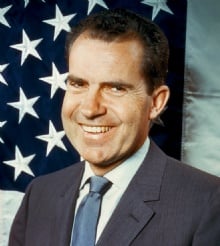Overview
Richard Nixon’s Six Crises is a political memoir and case study of leadership that traces six defining confrontations in his early career, from a freshman congressman battling alleged espionage to the razor-thin 1960 presidential defeat. Written with a prosecutorial eye for chronology and evidence, it mixes frontline narrative, tactical reflection, and media-savvy self-portraiture. Across domestic scandal, constitutional uncertainty, street violence abroad, and superpower showdowns, Nixon argues that character under pressure and meticulous preparation determine outcomes more than luck.
The Hiss Case
Nixon begins with the Alger Hiss investigation, recounting his role on the House Un-American Activities Committee and the fraught clash between Whittaker Chambers’s testimony and the State Department establishment. He dwells on the incremental grind of verification, the documents, deadlines, and “Pumpkin Papers”, and the political risks of pressing a case that many in Washington dismissed. The chapter establishes his themes of persistence against elite skepticism and the costs of pursuing charges in a polarized climate.
The Fund Crisis
The 1952 vice-presidential campaign nearly collapsed when reports surfaced of a private expense fund for Nixon’s political costs. He describes the shock, the media storm, and the tactical choice to go over the heads of intermediaries via national television. The “Checkers” broadcast, with line-by-line disclosure of personal finances and a notable vow to keep a family dog, reframed the controversy as a referendum on transparency and class resentment. Public response rescued the ticket, and Nixon marks the moment as a lesson in turning media peril into political capital by controlling facts and tone.
Eisenhower’s Illness
When President Eisenhower suffered a heart attack in 1955, Nixon, as vice president, confronted an undefined constitutional gray zone. He recounts chairing Cabinet and National Security Council meetings, preserving routine without overstepping, and consulting medical and legal authorities on presidential disability. The episode’s restraint, keeping decisions within established policy and avoiding the optics of a power grab, foreshadows later reforms and informs his view that clear contingency planning and disciplined communications avert secondary crises.
Caracas and the Perils of Public Diplomacy
On a 1958 goodwill tour, Nixon’s motorcade was attacked by a furious crowd in Caracas, Venezuela. He depicts the hours inside a battered car as a study in situational control: staying put to avoid escalation, coordinating with U.S. and local forces, and judging when to project defiance or seek extraction. He links the violence to regional grievances and communist agitation, concluding that face-to-face diplomacy carries hazards impossible to manage from a briefing book, yet indispensable for understanding anti-American sentiment.
Moscow and the Kitchen Debate
At the 1959 American National Exhibition in Moscow, a spontaneous exchange with Nikita Khrushchev in a model kitchen became a theater of Cold War ideology. Nixon portrays the debate as practiced spontaneity, facts, humor, and firmness, aimed as much at U.S. viewers as Soviet officials. He argues that public diplomacy, done live and unscripted, can puncture propaganda by personalizing abstract claims about productivity, freedom, and choice.
The 1960 Campaign
The final crisis covers the race against John F. Kennedy. Nixon recounts an early injury and hospitalization, the decision to visit all 50 states, and the unforgiving optics of the first televised debates, where fatigue and poor makeup fed an image gap. He contests the “missile gap,” defends the administration during the U-2 aftermath, and narrates election night’s razor-thin counts. Alleging irregularities in Illinois and Texas, he explains his decision not to litigate, casting it as a judgment that national stability mattered more than a contested mandate.
Throughline and Legacy
Threaded through the episodes are takeaways about preparation under uncertainty, tactical candor, disciplined rhetoric, and the strategic use of television. The book doubles as a defense of Nixon’s record and a primer on crisis management in the atomic age, arguing that stamina, facts, and timing convert pressure into leverage.
Six Crises
Richard Nixon's first memoir in which he reflects on his career, sharing insights on six pivotal moments in his political and personal life.
Author: Richard M. Nixon
 Richard Nixon, 37th President of the USA, known for Watergate scandal and diplomatic achievements like the China visit.
Richard Nixon, 37th President of the USA, known for Watergate scandal and diplomatic achievements like the China visit.
More about Richard M. Nixon
 Richard Nixon, 37th President of the USA, known for Watergate scandal and diplomatic achievements like the China visit.
Richard Nixon, 37th President of the USA, known for Watergate scandal and diplomatic achievements like the China visit.